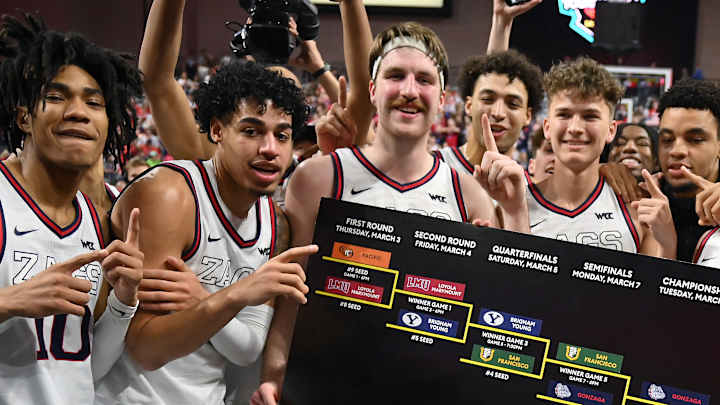Three ways the Zags improved from last season

Remember when people began to write off the Zags’ offseason as a failure? It feels like forever ago, but that narrative was thrown around just last month when it seemed plausible that the core of the team had moved on from Spokane for the NBA, leaving behind voids that weren’t readily filled. Because despite one of the biggest transfer portal pools in the history of college basketball, Gonzaga was passed over time and time again for lucrative opportunities elsewhere, whether it was another program or the draft.
But despite missing out on household names early on, Mark Few and the staff played the long game, and it paid off. After nabbing Efton Reid from LSU to bolster the frontcourt, the Zags picked up the reigning Southern Conference player of the year in Malachi Smith out of Chattanooga to complete one of the deepest rotations in the country. With Drew Timme, Rasir Bolton and Julian Strawther back together for another ride, those worries from last month are a thing of the past. Every way-too-early power ranking and poll for next season has Gonzaga right near the top of the totem pole once again, a spot they’ve grown accustomed to recently.
Still, there’s no replacing the level of individual talent last year’s team had. Chet Holmgren is going to be a top-2 pick in this month’s draft for more reasons than one, while Andrew Nembhard was quietly one of the game’s best floor generals as a senior who should also receive a call from an NBA team. Attempting to replace those two through recruiting or the transfer portal would be a waste of time.
Talent isn’t everything in sports, though, which is why the 2022-23 Bulldogs might be able to pull off the feat no team in program history has been able to do: win a national championship.
Here’s three reasons why the Zags are equipped for a deep run in the 2023 NCAA Tournament:
Depth
Let’s get the obvious out of the way to start; on paper, this is the deepest rotation Mark Few has ever had as head coach of the Bulldogs. The 2017 squad can make a compelling case for that title, but Rui Hachimura and Zach Norvell Jr. as freshmen weren’t as developed compared to the players at the end of this year’s rotation. It’s quite reasonable to expect platoon swaps of five, at least early on in the season, a luxury few collegiate programs can enjoy given the amount of roster turnover one offseason can bring.
Even before the addition of Smith, there were high hopes for the backcourt can achieve this season. Rasir Bolton became one of the most efficient players in the country last season, while Nolan Hickman and Hunter Sallis showed promise in their respective roles off the bench. Now in their second season, those two along with a healthy Dominick Harris combine one of the most athletic backcourts in school history with their speed and bounce. And with Smith in the fold too, his size at 6-foot-4 and over 200 lbs. bring the thunder to everyone else’s lightning.
The frontcourt boasts versatility as well with the addition of Reid, a powerful 7-footer who can run the floor on offense and protect the rim at the other end. Him and Anton Watson should be the defensive anchors this team needs. Oh, and Drew Timme is pretty good too.
And still, that’s not even counting Julian Strawther on the wing, who should see another major leap in development after testing his skills at the NBA draft combine. A healthy Kaden Perry brought an extra level of energy and hustle off the bench before injury derailed his freshman season.
Fatigue and burnout are legitimate concerns come postseason time for squads that go seven or even eight players deep. It’s a given that the rotation shortens in the biggest games, which makes it even more important to have quality depth throughout the long season. Last season’s starters, especially Andrew Nembhard, appeared gassed down the stretch at times in the tournament. But with a boatload of talent at numerous positions, Mark Few can point near the end of the bench and be pleased about the production he’ll get in return.
Athleticism
Recruiting sheer athletic freaks has never been a part of Gonzaga’s philosophy, for good reason at that, but having such intangibles can be a difference maker in a ballgame. Physically gifted opponents have been Gonzaga’s kryptonite in the past, from Florida State in 2018 to Baylor in 2021. Even Memphis from a few months ago pushed the No. 1 seed to the brink of elimination in the second round, and that was with Emoni Bates at less than 100%.
The athleticism on this year’s squad isn’t eye-popping, but it’s a noticeable change. The aforementioned Smith is a bruiser when he gets downhill off a screen, reminiscent of how Nigel Williams-Goss could use his size to shoot over the top of smaller defenders but with much more physicality at the rim. Sallis, Harris and Hickman are speedy high-fliers, while Reid in the frontcourt should be a bruiser on both ends of the floor.
It won’t be a defining characteristic, but late in the season against non-WCC teams, the Zags should be more confident in how they match up against physical opponents.
Experience
Gonzaga was hardly affected by the “one-and-done” plague that ran rampant in college basketball, and even early into the NIL era, not much has changed. The Zags once again will be among the “older” teams in college basketball and one of the few noteworthy programs that can trot out five upperclassmen in the starting lineup. More importantly, with that experience comes continuity in the case of returning players from last season.
Having a sense of familiarity with one another is an added advantage in more ways than one. Over time, players begin to develop a sense for where their teammates are on the floor at all times, allowing for more rhythm and smooth style of play. Mentally, it’s reassuring when everyone is on the same page and united to achieve a common goal, something the Zags showed last season with their tight-knit bonds both on and off the court. It was obvious these guys strive to play as one, and those bonds should grow stronger as the season progresses.
For “older” players like Bolton, Timme, Strawther and Watson, they’ve been in the big moments, some more than others. Everyone knows that the NCAA Tournament is Timme time, where he’s averaging 22.7 points per game on 62% shooting for his career (nine games) and has carried Gonzaga down the stretch a couple of times along the way. Though not spectacular at times, the remaining trio outside of Timme still played crucial minutes in last year’s tournament.
All that said, the 2022-23 Bulldogs are going to be a well-oiled machine like always, and with new faces in the fold, this has the makings of a team that is suited for a deep run in March.
